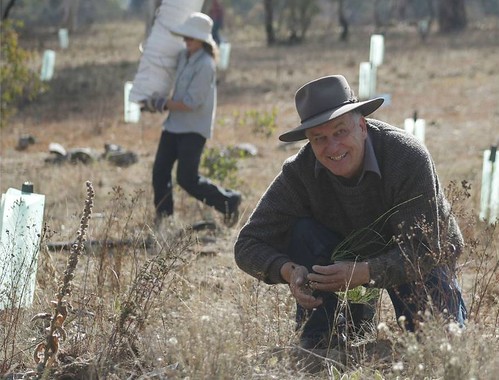Food for thought
 Friday, May 3, 2013 at 0:38
Friday, May 3, 2013 at 0:38  Senior threatened species officer Rainer Rehwinkel helps plant Drooping Sheoak seedlings at a Googong property in the hope of bolstering food supplies for the Glossy Black-Cockatoo. Photo: Kim Pham.HUNDREDS of Drooping Sheoak seedlings are being planted around the region in an effort to make meal times a little easier for the Glossy Black-Cockatoo.
Senior threatened species officer Rainer Rehwinkel helps plant Drooping Sheoak seedlings at a Googong property in the hope of bolstering food supplies for the Glossy Black-Cockatoo. Photo: Kim Pham.HUNDREDS of Drooping Sheoak seedlings are being planted around the region in an effort to make meal times a little easier for the Glossy Black-Cockatoo.
The Glossy Black-Cockatoo, classified as a vulnerable species, feeds exclusively on the cones from the Drooping Sheoak Tree. They crack the cones with their beak and eat the nutritious seeds located inside.
However, with a short supply of this particular type of tree, environmental organisation Greening Australia Capital Region has set about increasing the number of Drooping Sheoaks one seedling at a time.
The group has convinced about 20 landholders to agree to the planting of seedlings on their property. About half of these landholders are located in the Queanbeyan area.
Greening Australia project manager Nicki Taw said they were hoping to plant 10,000 seedlings covering an area from Canberra to Michelago.
"It's really important we start now, we've had some issues where the tree species hasn't been able to regenerate because of grazing from stock, wallabies or rabbits," she said. "A lot of Drooping Sheoak trees disappeared when they cleared hilltops and were also taken for its timber and used for firewood."
Ms Taw said it would take another seven years for the seedlings to grow and start flowering cones for the birds.
Senior threatened species officer Rainer Rehwinkel said it was important to have clusters of Drooping Sheoaks located around the area. He said it would make finding food a lot easier for Glossy Black-Cockatoos.
"With a larger population of the trees, it ensures the Glossy Black-Cockatoos won't have to travel as far for food," he said.
"We're aiming to bolster what's already there. Our main concern is to look after the landscape connectivity that is the population of animal and plants across the land.
"If you don't connect population, the climate declines and peters out and the species becomes extinct."
The Greening Australia project is one of the few in the region where planting areas have been specifically mapped to help vulnerable species. It is hoped this practice of trageting certian areas will be used more in the future.
For more information please visit:

